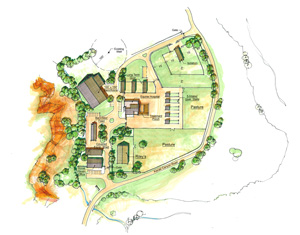These are stressful times for equine veterinarians. Studies by the American Veterinary Medical Association and the U.S. Bureau of Labor Statistics from 2008 conclude that there is a shortage of about 4,000 veterinarians nationwide. Equine and large animal veterinarians are the most in demand as a greater percentage of veterinary school graduates choose to practice small animal medicine.

Most equine veterinarians work too hard, drive too much and find to their dismay that it becomes harder to attract young associates to help share the load. As a result of the pressure, some equine practices are moving toward building a hospital as a “home base.” A new hospital can help to reduce hours on the road and can be a catalyst for practice growth and for attracting top veterinary school graduates.
While a hospital can be a tremendous boon for a practice, building one is a significant investment in time and money. Before you start the design process, there are a number of steps that you should take to ensure your success.
The Building Program The first step is to determine the scope and scale of your project by developing a building program, which is a written wish list. An architect should help you fine-tune your program to get an exact idea of the size of your hospital. However, you can develop an initial idea by adding up the square footages of each room that you plan to build and multiplying by a grossing factor of 133 percent, which generally accounts for wall thicknesses and building circulation. Be aware that the hospital may be slightly larger than your initial projections.
How Much Will it Cost? Once you have determined the approximate size of your hospital, multiply by a cost-per-square-foot number to determine how much the building is likely to cost. It is surprising to many equine veterinarians that equine hospitals cost about the same per square foot as small animal hospitals. Although costs vary widely across the country, averages range about $250 per square foot for “hard” construction costs for the hospital itself; the barns will cost significantly less. In addition, it is reasonable to expect another 25 to 30 percent in “soft” costs, including fees, permits, financing costs, professional services, equipment and furnishings. If you do not own your land, you will also need to factor in the cost of purchasing a piece of property and bringing utilities to the site.
Financing the Hospital One of the more common ways veterinarians finance the construction of their hospitals is with a commercial loan through a bank where they have an established relationship. The same bank can help with securing an SBA loan. There are also a number of lending institutions that cater specifically to veterinarians. When working with lenders, always check references and be cautious when deals seem too good to be true.
In this tough lending market, not getting an adequate appraisal is one of the most common and frustrating problems. You can help with the appraisal process by tracking down appropriate “comps” or comparable projects. The best comps are other veterinary hospitals, especially equine hospitals.
Master Planning This last pre-design step is perhaps the most important. Many equine veterinary hospitals grow without the benefit of advanced planning. This can lead to a variety of long-term woes, including inefficient traffic patterns and inappropriate adjacencies of buildings and services.
A facility master plan is a relatively small initial investment that will bring you enormous return over the long run. A master plan should include the following information:
- A phase-one program of spaces and a proposed program for future additions
- The placement of current and future buildings
- Current and future vehicular and equine circulation patterns
- Locations of current and future service areas and waste management areas
It is generally a lot more fun to design a hospital than to pre-plan one, but a thoughtful pre-design stage will pay off in the long run by reducing risk and preventing unexpected surprises. The good news is that, on the whole, equine veterinary practices that are able to pull off building a hospital also build for the future. A new hospital is a springboard for success.
SIDEBAR
A Business Plan
If you have completed your pre-planning stages, you are probably feeling overwhelmed. It is important to develop your business plan to know what steps must be taken to ensure that the financial risk you are taking will pay off.
A business plan should include the overall vision of the growth of your practice, as well as the steps you will need to take to get there, including adding new services, hiring new doctors and staff, etc. Many practices also complete demographic studies in order to project the market demand in a particular area. Do not neglect developing a pro-forma balance sheet that outlines how much you will need to net after expenses in order to pay off your loan amount within a set period of time. You may find it helpful to contact other colleagues who have built hospitals recently to learn from their experiences. There are plenty of resources available for building a business plan, from your local Small Business Administration office to practice management consultants.
Heather E. Lewis, AIA, NCARB, is a principal of Animal Arts, an architectural firm that has exclusively designed animal hospitals and animal-care facilities since 1979.








